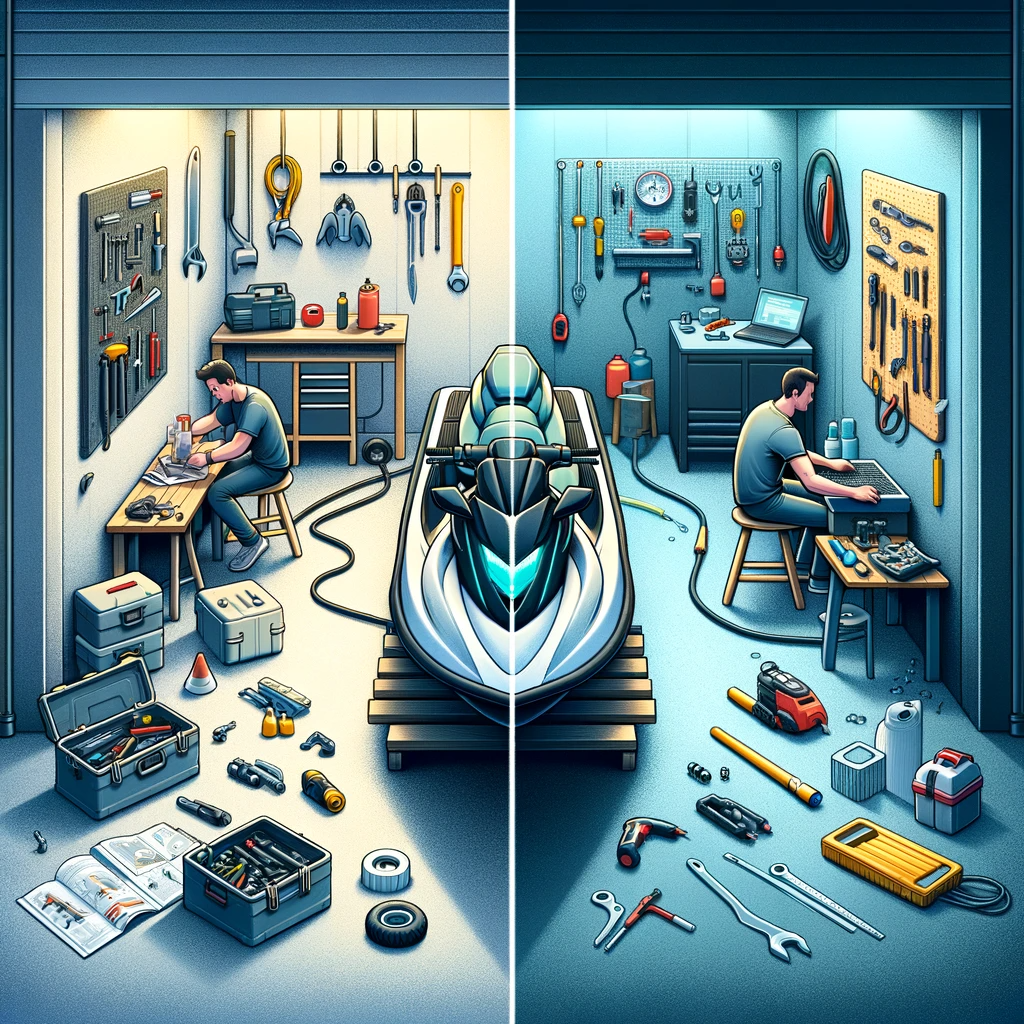DIY vs. Professional Services: Making the Right Choice

Jet skiing is an exhilarating water sport that offers endless fun and excitement. But when it comes to maintaining and repairing your jet ski, you might find yourself torn between the options of doing it yourself or seeking professional help. In this article, we will explore the pros and cons of both DIY and professional services, helping you make the right choice for your jet ski. Whether you’re a seasoned jet skier or a beginner, read on to discover the best way to keep your ride in top shape. And if you’re looking to rent a jet ski from trusted watersport experts, we highly recommend A2Z Powersport located in Orange Beach, AL at the Fort Morgan Marina. Their experienced team and top-notch services are sure to enhance your jet skiing experience. Contact them at (954) 296 1862 or bookings@a2zpowersport.com to book your adventure today.
Overview of DIY vs. Professional Services
When it comes to completing tasks or projects, whether it’s maintaining and cleaning a jet ski or tackling complex repairs and modifications, you have two options: do-it-yourself (DIY) or hire professional services. Choosing the right option for your specific needs is crucial as it can have a significant impact on the outcome and overall experience. In this article, we will explore the importance of making the right choice between DIY and professional services, and discuss the factors to consider before making a decision.
Importance of Choosing the Right Option
The decision between DIY and professional services is an important one to consider because it can ultimately determine the success and satisfaction you achieve with your project. Making an informed choice ensures that you choose the option that aligns with your goals, resources, and capabilities. Whether it’s saving money, gaining knowledge and personal satisfaction, or ensuring quality and expertise, understanding the pros and cons of each approach will help you make an educated decision.
Factors to Consider Before Making a Choice
Before delving into the advantages and disadvantages of DIY and professional services, it is important to assess certain factors that can influence your decision. Consider the following before making a choice:
Nature and Complexity of the Task
First and foremost, evaluate the nature and complexity of the task at hand. Some projects may be relatively simple and straightforward, while others require specialized skills and expertise. Understanding the intricacies of the task will help you determine if it is something you can confidently tackle yourself or if it necessitates professional intervention.
Available Resources and Budget
Consider the resources and budget you have available. DIY projects often require acquiring the necessary tools, equipment, and materials, which can add up in cost. On the other hand, professional services come at a price, and you need to ensure that it fits within your budget. Evaluate whether you have the financial means to invest in professional services or if you can allocate the necessary resources for a DIY project.
Time Constraints
Assess the time constraints you are facing. DIY projects often demand significant time and effort, especially if you are unfamiliar with the task at hand. Consider if you have the luxury of dedicating the necessary time to complete the project yourself or if you need a more time-efficient solution by hiring professionals.
Skill Level and Experience
Evaluate your own skill level and experience in the specific area related to the project. Some projects may require technical expertise or professional training, which you may not possess. However, if you have prior experience, knowledge, or a desire to learn, DIY may be a viable option. Be honest with yourself about your capabilities and assess if you are willing to invest the time and effort to acquire the necessary skills.
Safety and Legal Considerations
Consider safety and legal implications associated with the task. Some projects, especially those involving mechanical systems or electrical components, carry risks that may require professional knowledge to mitigate. Additionally, certain tasks may have legal requirements or regulations that must be adhered to. Prioritize safety and ensure you are aware of any legal considerations before deciding between DIY or professional services.
Advantages of DIY
Now that we have explored the factors to consider, let’s delve into the advantages and disadvantages of each approach, starting with DIY.
Cost-Effectiveness
One of the primary advantages of opting for the DIY approach is cost-effectiveness. By handling the project yourself, you can save money by avoiding the costs associated with hiring professional services. DIY projects often require purchasing materials and equipment, but in the long run, it can be more economical compared to paying for labor and service fees.
Flexibility and Convenience
DIY projects provide flexibility and convenience since you can work on your own timeline and at your own pace. You have the freedom to choose when and how you want to complete the project, allowing you to fit it into your schedule. Additionally, you can adapt and modify your plans along the way, providing a more personalized touch to the final outcome.
Opportunity for Learning and Personal Satisfaction
Undertaking a DIY project offers a valuable opportunity for learning and personal satisfaction. By immersing yourself in the task, you can acquire new skills, expand your knowledge, and gain a sense of accomplishment. Whether it’s learning how to troubleshoot mechanical issues or mastering new techniques, DIY projects offer a chance to develop expertise and enhance your self-confidence.
Disadvantages of DIY
While DIY projects have their advantages, it is important to carefully consider the disadvantages as well.
Lack of Expertise and Professional Knowledge
One of the drawbacks of DIY projects is the potential lack of expertise and professional knowledge. Some tasks may require specialized skills and technical know-how that you may not possess. This can lead to mistakes, inefficiencies, and suboptimal outcomes. Without professional guidance, you may find yourself stuck when faced with challenges or uncertainty.
Potential Risks and Safety Concerns
DIY projects can also present risks and safety concerns. Certain tasks, such as major repairs or electrical work, involve inherent risks that require proper training and precautions. Without the necessary expertise, you may inadvertently put yourself or others at risk. It is important to assess the potential hazards associated with the project and determine if you have the required skills to handle them safely.
Time and Effort Required
Undertaking a DIY project often demands a significant amount of time and effort. As a DIY enthusiast, you may need to invest extensive hours in researching, planning, and executing the project. Additionally, you may encounter unexpected obstacles or setbacks along the way, further prolonging the time investment required. Assess whether you have the available time and commitment before committing to a DIY endeavor.
Advantages of Professional Services
Now let’s explore the advantages of opting for professional services.
Expertise and Specialized Knowledge
Hiring professional services provides access to expertise and specialized knowledge. Professionals are well-versed in their respective fields, possessing the necessary training, certifications, and experience to handle complex tasks. By entrusting the project to experts, you can have peace of mind knowing that it is in capable hands.
Guaranteed Quality and Results
Professional services often come with a guarantee of quality and results. When you hire a professional, you can expect a high standard of workmanship and attention to detail. Professionals have the experience and resources to deliver superior outcomes and ensure that the project is completed to your satisfaction. This can save you time, effort, and potentially costly mistakes in the long run.
Time-Saving and Convenience
By hiring professionals, you save yourself the time and effort required to complete a project on your own. Professionals are equipped with the necessary tools, knowledge, and experience to efficiently execute tasks. They can complete the project within a specified timeframe, allowing you to focus on other priorities or enjoy the end result sooner.
Disadvantages of Professional Services
As with any approach, professional services also have their disadvantages that should be considered.
Higher Cost
One of the main drawbacks of professional services is the higher cost compared to DIY. Hiring professionals involves paying for their expertise, labor, and overhead expenses. The cost can vary significantly depending on the complexity of the project and the reputation and location of the professionals. It is important to assess your budget and determine if the benefits outweigh the financial investment.
Limited Control and Decision-Making
When you choose professional services, you relinquish some control and decision-making power over the project. Professionals follow their own methodologies, techniques, and timelines, and you may have limited influence over the specifics. This can be challenging if you have a specific vision or preference for the project outcome. Determine whether you are comfortable surrendering control or if having full decision-making power is critical for your project.
Reliance on External Parties
By opting for professional services, you become reliant on external parties to complete the project. This means that you are subject to their availability and scheduling constraints. Delays or cancellations can occur, potentially disrupting your plans. It is important to ensure clear communication, establish expectations, and maintain flexibility to mitigate any potential issues.
Factors to Consider When Choosing DIY or Professional Services
Now that we have discussed the advantages and disadvantages of both approaches, let’s summarize the key factors to consider when making your choice.
Nature and Complexity of the Task
Evaluate the complexity of the task and determine if it requires specialized skills or knowledge that you lack. Simpler tasks that align with your capabilities may be suitable for a DIY approach, while more complex projects may necessitate professional assistance.
Available Resources and Budget
Consider your available resources and budget. Determine if you have the necessary tools, materials, and equipment for a DIY project. Assess if your budget permits hiring professionals without compromising other financial obligations.
Time Constraints
Assess your time constraints and commitments. Determine if you have the availability and willingness to invest the time required for a DIY project. Consider if your schedule permits supervising and coordinating professional services within the desired timeframe.
Skill Level and Experience
Evaluate your own skill level and experience related to the project. Assess if you possess the required expertise or if you have the motivation and time to learn new skills. Consider seeking professional help if the task demands specialized knowledge.
Safety and Legal Considerations
Prioritize safety and ensure compliance with any legal requirements or regulations associated with the task. Assess if the project presents any safety risks that you are equipped to handle, or if professional intervention is necessary to ensure a safe and compliant outcome.
Examples of DIY Projects
To provide a better understanding of the types of projects that can be tackled using a DIY approach in the Jet Skiing industry, here are a few examples:
Jet Ski Maintenance and Cleaning
Routine maintenance tasks such as cleaning the jet ski, changing oil and filters, and inspecting and lubricating moving parts can often be DIY projects. With the right tools and resources, jet ski owners can save money and gain a sense of accomplishment by maintaining their watercraft themselves.
Minor Repairs and Replacements
Simple repairs and replacements, such as fixing minor leaks, replacing damaged seats or handles, or adjusting the carburetor, can be within the capabilities of DIY enthusiasts. These tasks often require basic mechanical knowledge and can save jet ski owners the expense of hiring professional services.
Basic Modifications and Upgrades
Making basic modifications and upgrades, such as adding custom graphics, installing speakers or a new handlebar grip, or upgrading the exhaust system, can be exciting DIY projects. Jet ski owners can personalize their watercraft and enhance its performance without needing professional assistance.
Examples of Projects Requiring Professional Services
On the other hand, certain projects in the jet skiing industry are best left to the professionals. Here are a few examples:
Major Engine Repairs and Overhauls
Major engine repairs and overhauls can be complex and require specialized knowledge and tools. Engaging professional services ensures that the intricate mechanical aspects of the jet ski are handled by experts, avoiding potential mistakes or further damage.
Custom Performance Tuning and Modifications
For those looking to enhance the performance of their jet ski or undertake complex modifications, professional services are highly recommended. Professionals can fine-tune the performance, optimize handling, or install high-performance parts to meet specific requirements or preferences.
Complex Electrical System Troubleshooting
Troubleshooting complex electrical issues, such as diagnosing faulty wiring, repairing electrical components, or upgrading the electrical system, often demands precise knowledge and expertise. Professionals possess the necessary skills and equipment to efficiently identify and resolve electrical problems.
Case Study: Renting a Jet Ski
To further illustrate the choice between DIY and professional services, let’s explore the scenario of renting a jet ski.
Benefits of Renting from Professionals
Renting a jet ski from professionals offers several advantages. Established watersport experts, such as A2Z Powersport located in Orange Beach, AL, provide well-maintained, reliable jet skis that undergo regular inspections and maintenance. They ensure a safe and enjoyable experience for customers, along with offering insurance coverage and safety equipment. Renting from professionals eliminates the need for customers to invest in their own watercraft, storage, or maintenance.
Considerations for DIY Rental
While some may consider DIY rental, it is crucial to assess the challenges and drawbacks. Renting a jet ski requires careful consideration of licensing and legal requirements, as well as ensuring the availability of appropriate safety equipment. Furthermore, DIY rental may involve additional logistical challenges, such as finding suitable transportation options and navigating unfamiliar waters. Engaging professional rental services provides peace of mind, convenience, and a hassle-free experience.
Conclusion
When faced with the choice between DIY and professional services in the jet skiing industry, it is essential to make an informed decision based on your individual circumstances and preferences. Consider the nature and complexity of the task, available resources and budget, time constraints, skill level and experience, and safety and legal considerations. Weigh the advantages and disadvantages of each option, carefully evaluating the pros and cons. Whether you choose to embark on a DIY project to save money and gain personal satisfaction, or opt for professional services to ensure expertise and guaranteed results, remember that your choice has the power to shape your experience and the outcome of your project.












